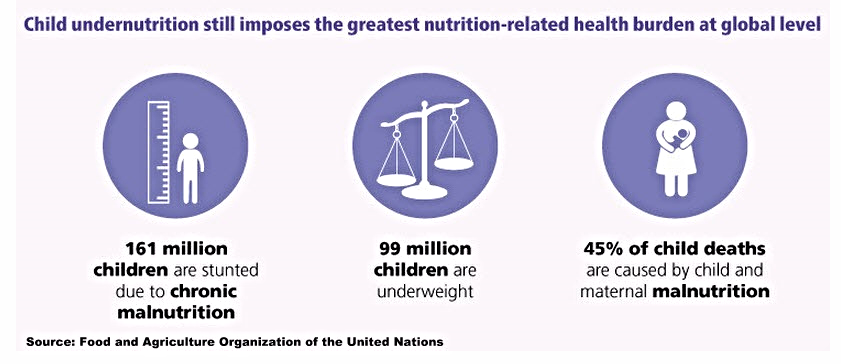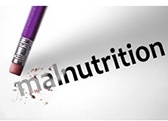-
How Dairy Nutrition Accelerates Economic Growth
By Véronique Lagrange February 23, 2016- Tweet
Tackling child malnutrition makes dairy protein a global economic development tool.
Addressing moderate malnutrition in children has become a priority for nutrition programs around the world because of the link between physical and cognitive growth and, potentially, economic development.
Malnutrition can lead to reductions in a child’s cognitive development, resulting in poor school performance and reduced productivity in the workforce. In fact, it has the ability to reduce a nation’s workforce by up to 8% and national GDPs by up to 16.5%, according to the “The Cost of Hunger in Africa” study led by African development and policy groups and supported by the United Nations' World Food Program.
That study goes on to note there are more stunted children (below normal height) in Africa today than there were 20 years ago. In some countries of sub-Saharan Africa, the stunting rate in children under the age of 5 is around 40%, according to data from The World Bank. Stunting can be addressed through improved nutrition that includes dairy protein.

Proven health benefits
Health benefits have been demonstrated with milk powder and whey protein when it is included in ready-to-use supplementary foods products purchased by the World Food Program USA and USAID.
New research is testing the feasibility of providing dairy-enriched nutritional supplements for all children under two years of age in vulnerable populations to reduce stunting and another growth-deficit syndrome known as wasting, says this report from Dairy for Global Nutrition.
That report goes on to add, “Recent innovations in nutritional products for children at risk of stunting and wasting include paste-based, shelf-stable recipes similar to the "ready-to-use therapeutic foods" products, but with reduced caloric and nutritional content. These "ready-to-use supplementary foods" are designed to complement rather than replace the child's standard diet. A lower-cost alternative, used by UNICEF and recently adopted by World Food Program, is an enriched grain-based product (such as corn-soy blend), incorporating micronutrients and more recently, dairy proteins. The dairy-inclusive formulas are known as Supercereal Plus. Research is underway to test the relative health outcomes of these different options.”

As recent data suggest, the amount of milk protein is a critical factor for therapeutic foods. If it is below active threshold, the product may not be effective, and if above, the need results in wasted resources and higher costs. This is what we strive to discover: the amount of dairy protein which can be an effective component for recovery from malnutrition at each and every stage of the first 1,000 days of life, and how to cost-optimize the food intervention.
Dairy proteins superior to plant proteins
Despite the higher cost of dairy ingredients, they offer more overall benefit than less-expensive protein sources.
At the Experimental Biology meeting last spring in Boston, Shebang Ghosh, of the Friedman School of Nutrition Science and Policy, presented evidence linking protein quality to low stunting incidence and introduced the Digestible Indispensable Amino Acid Score (DIAAS), a new scoring pattern for protein recommended by the Food and Agriculture Organization of the United Nations.
Mark Manary, pediatrician at Washington University School of Medicine in St. Louis, Department of Pediatrics, affirmed the accuracy of DIAAS over the old Protein Digestibility Corrected Amino Acid Score to measure protein quality. He also presented research that establishes a strong correlation between protein quality as measured by DIAAS and rates of weight gain in malnourished children.
DIAAS clearly demonstrates the superiority of dairy proteins over plant proteins, measuring a 25-30% nutritional advantage over soy and pea protein.
Manary was a co-author of an article in The American Journal of Clinical Nutrition that highlighted the importance of milk protein in the treatment of moderate acute malnutrition in children. A novel, ready-to-use supplementary food (RUSF) containing dairy ingredients in the form of whey permeate and whey protein concentrate resulted in higher recovery rates and improved growth than a RUSF with soy protein.

The bottom line: Dairy protein can be an effective tool in addressing the negative health and economic impacts of undernutrition in young children. That can translate into a healthier, more productive population, making dairy nutrition an accelerator of economic growth.
Learn more: Related articles have appeared in the U.S. Dairy Exporter Blog:
- 5 Research-Based Strategies to Improve Whey Protein Messaging
- With Protein, U.S. Dairy Plays to its Strengths
- Dairy Makes a Case as a Remedy for Malnutrition
Subscribe to the U.S. Dairy Exporter Blog
The U.S. Dairy Export Council fosters collaborative industry partnerships with processors, trading companies and others to enhance global demand for U.S. dairy products and ingredients. USDEC is primarily supported by Dairy Management Inc. through the dairy farmer checkoff. How to republish this post.
10 Most Recent Posts
Most Popular Posts in Past Year
Index of Posts by Topic
- #GotDairyJobs (4)
- About USDEC (66)
- Africa (6)
- Australia (4)
- Blog (8)
- Brazil (4)
- Canada (20)
- Central America (1)
- Cheese (58)
- Chile (1)
- China (54)
- Common food names (7)
- Company News (20)
- Consistent Supply (1)
- Crisis Management (3)
- Cuba (2)
- Dairy (6)
- Dairy checkoff (9)
- Dairy Ingredients (5)
- Dairy Management Inc. (2)
- Dairy Resources (1)
- Dairy Supply Chain (1)
- Dairy Trends (5)
- Documentation (3)
- EU (24)
- Experts on Dairy Exports (4)
- Exporter of the Year (2)
- Exports (24)
- Farmer leaders (1)
- Farming (38)
- Food Aid (8)
- Food Safety (8)
- Foodservice (3)
- Free trade agreements (34)
- Future trends (1)
- Geographical Indications (GIs) (10)
- Global Marketing (86)
- Global Shipping Crisis (1)
- Got Jobs? (9)
- Indonesia (1)
- Innovation (17)
- Japan (17)
- Krysta Harden (1)
- Market Access (25)
- Market Conditions (268)
- Member Services (17)
- Mexico (41)
- Middle East (9)
- Middle East & North Africa (3)
- Middle East/North Africa (9)
- Milk (4)
- Milk Protein Concentrate (MPC) (2)
- New Zealand (11)
- Next5% (20)
- Nonfat Dry Milk/Skim Milk Powder (8)
- Nutrition (19)
- Product Innovation (6)
- Protein (4)
- Regulations (5)
- Research & Data (326)
- Russia (3)
- Singapore (10)
- South America (8)
- South Korea (10)
- Southeast Asia (25)
- Strategic Insights (1)
- Supply (1)
- Sustainability (26)
- Technology (2)
- ThinkUSADairy (5)
- TPM23 (1)
- TPP (13)
- Traceability (8)
- Trade Barriers (5)
- Trade Data (7)
- Trade Policy (72)
- TTIP (5)
- UHT Milk (7)
- USMCA (2)
- Vietnam (4)
- Whey (6)
- Whey Ingredients (2)
- Whey products (10)
- Whole Milk Powder (WMP) (3)
- World Dairy Expo (1)
- World Milk Day (1)
- Yogurt (1)
Index of Posts by Date, Author
- June 2021 (13)
- March 2015 (12)
- September 2015 (12)
- April 2015 (11)
- December 2015 (11)
- March 2014 (10)
- February 2015 (10)
- October 2015 (10)
- October 2014 (9)
- June 2015 (9)
- July 2015 (9)
- November 2015 (9)
- March 2016 (9)
- October 2019 (9)
- September 2013 (8)
- May 2015 (8)
- August 2015 (8)
- January 2016 (8)
- February 2016 (8)
- March 2017 (8)
- December 2018 (8)
- May 2019 (8)
- December 2019 (8)
- June 2014 (7)
- November 2016 (7)
- May 2017 (7)
- May 2018 (7)
- July 2020 (7)
- June 2023 (7)
- July 2016 (6)
- August 2018 (6)
- October 2018 (6)
- November 2018 (6)
- February 2019 (6)
- June 2019 (6)
- August 2019 (6)
- March 2020 (6)
- April 2020 (6)
- June 2020 (6)
- June 2022 (6)
- February 2014 (5)
- June 2016 (5)
- August 2016 (5)
- September 2016 (5)
- December 2016 (5)
- February 2017 (5)
- July 2017 (5)
- October 2017 (5)
- January 2018 (5)
- April 2018 (5)
- June 2018 (5)
- July 2018 (5)
- September 2018 (5)
- January 2019 (5)
- March 2019 (5)
- April 2019 (5)
- July 2019 (5)
- September 2019 (5)
- November 2019 (5)
- January 2020 (5)
- August 2020 (5)
- October 2020 (5)
- April 2021 (5)
- January 2022 (5)
- May 2013 (4)
- September 2014 (4)
- April 2016 (4)
- May 2016 (4)
- October 2016 (4)
- January 2017 (4)
- April 2017 (4)
- June 2017 (4)
- August 2017 (4)
- September 2017 (4)
- December 2017 (4)
- February 2018 (4)
- February 2020 (4)
- May 2020 (4)
- February 2022 (4)
- September 2022 (4)
- April 2023 (4)
- December 2023 (4)
- November 2017 (3)
- March 2018 (3)
- September 2020 (3)
- December 2020 (3)
- February 2021 (3)
- May 2021 (3)
- August 2021 (3)
- December 2021 (3)
- March 2022 (3)
- April 2022 (3)
- May 2022 (3)
- October 2022 (3)
- December 2022 (3)
- May 2023 (3)
- July 2023 (3)
- November 2023 (3)
- March 2011 (2)
- June 2011 (2)
- September 2011 (2)
- March 2012 (2)
- June 2012 (2)
- July 2012 (2)
- March 2013 (2)
- July 2013 (2)
- November 2020 (2)
- January 2021 (2)
- March 2021 (2)
- July 2021 (2)
- September 2021 (2)
- October 2021 (2)
- November 2021 (2)
- July 2022 (2)
- August 2022 (2)
- January 2023 (2)
- March 2023 (2)
- October 2023 (2)
- January 2024 (2)
- February 2024 (2)
- April 2024 (2)
- June 2024 (2)
- July 2024 (2)
- November 2024 (2)
- December 2024 (2)
- February 2025 (2)
- June 2025 (2)
- July 2025 (2)
- September 2025 (2)
- November 2025 (2)
- December 2025 (2)
- January 2010 (1)
- February 2010 (1)
- March 2010 (1)
- April 2010 (1)
- May 2010 (1)
- June 2010 (1)
- July 2010 (1)
- August 2010 (1)
- September 2010 (1)
- October 2010 (1)
- November 2010 (1)
- December 2010 (1)
- January 2011 (1)
- February 2011 (1)
- April 2011 (1)
- May 2011 (1)
- July 2011 (1)
- August 2011 (1)
- October 2011 (1)
- November 2011 (1)
- December 2011 (1)
- January 2012 (1)
- February 2012 (1)
- April 2012 (1)
- August 2012 (1)
- September 2012 (1)
- October 2012 (1)
- November 2012 (1)
- December 2012 (1)
- January 2013 (1)
- February 2013 (1)
- April 2013 (1)
- June 2013 (1)
- August 2013 (1)
- October 2013 (1)
- November 2013 (1)
- December 2013 (1)
- January 2014 (1)
- April 2014 (1)
- May 2014 (1)
- November 2022 (1)
- February 2023 (1)
- August 2023 (1)
- September 2023 (1)
- March 2024 (1)
- May 2024 (1)
- August 2024 (1)
- September 2024 (1)
- October 2024 (1)
- January 2025 (1)
- March 2025 (1)
- April 2025 (1)
- May 2025 (1)
- August 2025 (1)
- USDEC (183)
- USDEC Staff (164)
- Alan Levitt (119)
- Tom Suber (41)
- Margaret Speich (22)
- Marc A.H. Beck (15)
- Vikki Nicholson-West (11)
- Angélique Hollister (11)
- Tom Vilsack (8)
- Jaime Castaneda (7)
- Matt McKnight (7)
- Véronique Lagrange (7)
- Margaret Speich and Mark O'Keefe (7)
- Ross Christieson (7)
- Paul Rogers (6)
- Shawna Morris (5)
- William Loux (5)
- Alan Levitt and Marc Beck (5)
- Krysta Harden (4)
- USDEC Communications (3)
- Kristi Saitama (3)
- Marilyn Hershey (3)
- Brad Gehrke (3)
- Tom Quaife (2)
- Nick Gardner (2)
- Jim Mulhern (2)
- Alan Levitt and William Loux (2)
- Kara McDonald (2)
- Luke Waring (2)
- Merle McNeil (2)
- Andrei Mikhalevsky (1)
- Rodrigo Fernandez (1)
- Dermot Carey (1)
- Jeremy Travis (1)
- Annie Bienvenue (1)
- Ross Christieson and Shawna Morris (1)
- Becky Nyman (1)
- Paul Rogers and Tom Quaife (1)
- Rick Ortman (1)
- Tony Rice (1)
- Barbara O’Brien (1)
- Paul Rogers and Mark O'Keefe (1)
- Dalilah Ghazalay (1)
- Amy Wagner (1)
- Mitchell Bowling (1)
- Erica Louder (1)
- Brad Scott (1)
- Amy Foor (1)
- Scott Lantz (1)
- Sandra Benson (1)
- Errico Auricchio (1)
- Jaclyn Krymowski (1)
- Krysta Harden, USDEC President and CEO (1)
.png)

